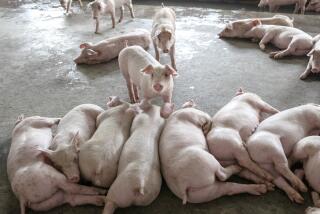Bird Flu May Hit Europe, Russia Says
- Share via
MOSCOW — Russian authorities, struggling to contain an outbreak of avian flu that has killed thousands of birds in Siberia, acknowledged Thursday that a spread of the virus into Europe seemed almost inevitable.
“It is quite likely that the flu will creep westward. What else can it do? The infection is picking up momentum,” said Viktor Maleyev, deputy director of the Russian Health Ministry’s Institute of Epidemiology.
Equally worrisome, health officials confirmed that the outbreak included H5N1, a strain that has been known to affect humans. Scientists fear that expansion of the virus’ terrain increases the risk of a major outbreak within the human population.
Although there have been isolated cases of avian flu around the world, including in the U.S., the most dangerous strain of the virus has appeared mostly in Asia, with human cases reported in Vietnam, Indonesia, Thailand and Cambodia.
Some poultry farms on the western side of the Ural Mountains -- the dividing line between European and Asian Russia -- are under precautionary alerts. In Murmansk and in the populous Moscow region, imports of birds and feed are being tracked for possible signs of infection.
Authorities said the virus would probably spread along the paths of migratory waterfowl, which within the next month or two will begin flying out of Siberia toward warmer climes along the Volga River and eventually the Black Sea and Southern Europe. Large numbers of wild waterfowl have died on Siberian lakes in addition to the deaths among domestic geese and chickens.
“In autumn, some wild birds migrate from the northern part of Siberia to the Caspian and Black Sea regions,” the Emergency Situations Ministry said in a statement.
“Risks of epidemic outbreaks in the industrial poultry breeding sector therefore increases, and losses in zones of infection may be as high as 75% to 100% of the poultry population. Human infection, especially among workers at poultry farms, cannot be ruled out,” the ministry said.
On Thursday, three more districts of the Altai region in Siberia reported mass deaths of poultry, and Russian television showed government workers in white protective suits slaughtering hundreds more birds at infected farms.
In some towns, citizens created roadblocks to prevent desperate farmers from evading quarantines and escaping with their flocks.
So great was the fear of human infection that health officials set up quarantine rooms in hospitals and began screening residents of the affected areas who showed signs of a fever. However, there have been no confirmed human cases in Russia so far.
“Medical personnel will be doing the rounds from house to house,” Gennady Onishchenko, chief state epidemiologist, said at a news conference in Novosibirsk. “What is the point of these house-to-house rounds? To identify people who are sick. That is to say, any temperature is enough to actively monitor that person’s health to find out the nature of that temperature.”
This week, a man in neighboring Kazakhstan reported to have come down with avian flu was found to have pneumonia. The virus has claimed 55 human lives worldwide, though there have been no documented cases of human-to-human transmission.
Still, that remains a possibility, and a growing one as long as the virus continues to expand its range, scientists say. That risk could lead to an influenza pandemic.
“What we fret about is the more widespread these avian viruses are, the greater the likelihood that they will buddy up to a human influenza virus in a single animal, perhaps a human, and exchange genetic material and develop the capacity to spread -- or just mutate into that virus themselves,” said William Schaffner, chairman of the department of preventive medicine at Vanderbilt University.
“The threat lies in the multitude of possible scenarios,” Maleyev said. “That the flu could gradually spread to a greater number of people. That the bird flu could mix with other sorts of infections. We do not have any reliable forecasts.”
Maleyev said that although the migratory patterns of wild birds in Russia carried the possibility of transmission into Europe and, theoretically, North America, the risk was mitigated by Russia’s harsh winters.
“The one thing that could help us is the cold weather,” he said. “Unlike Southeast Asia, Russia will get a cold spell, possibly as early as September, and that might stem the spread.”
*
Natasha Yefimova of The Times’ Moscow Bureau contributed to this report.
More to Read
Sign up for Essential California
The most important California stories and recommendations in your inbox every morning.
You may occasionally receive promotional content from the Los Angeles Times.










